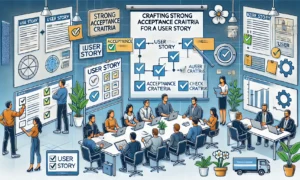In today’s saturated tech market, where innovation cycles are shorter, and competition is fierce, delivering a standout User Experience (UX) has emerged as a critical differentiator. From startups to industry giants, companies that prioritize UX create loyal customer bases, drive engagement, and establish their products as leaders in their categories.
This blog explores how user experience shapes product success, why it’s a differentiator, and how product managers can harness UX to win in competitive tech markets.
What Is User Experience, and Why Does It Matter?
User Experience encompasses the entire journey users have with a product, including how they interact with its design, features, and functionality. A seamless UX makes products intuitive, efficient, and delightful to use.
Why UX Matters in Tech Markets
- Customer Retention: A well-designed experience keeps users engaged and reduces churn.
- Competitive Edge: Products with superior UX often win customers over even if competitors have similar features.
- Revenue Impact: Better UX leads to higher customer satisfaction, driving referrals, upsells, and repeat purchases.
How UX Differentiates Products in Competitive Markets
1. Simplifies Complex Technology
In industries like SaaS, AI, or IoT, technical complexity can deter adoption. UX bridges the gap by making complex systems approachable.
- Example: Slack transformed workplace communication by integrating advanced features into a simple, user-friendly interface.
- Key Takeaway: Simplified user workflows reduce friction and foster higher adoption rates.
2. Builds Emotional Connections
Products that evoke positive emotions through thoughtful design build deeper relationships with users.
- Example: Apple’s meticulous design ethos creates an emotional attachment to its ecosystem.
- Key Takeaway: Emotional resonance turns users into brand advocates, setting a product apart.
3. Facilitates Rapid Decision-Making
In fast-paced markets, users prefer products that save them time and effort. UX can make decision-making quicker by providing clarity and intuitive navigation.
- Example: Netflix’s recommendation engine paired with seamless navigation keeps users engaged without effort.
- Key Takeaway: Anticipating user needs leads to quicker, more enjoyable decisions.
The Role of Product Managers in UX Differentiation
Product managers (PMs) are pivotal in ensuring UX becomes a competitive advantage. Their role involves strategizing, collaborating, and prioritizing UX throughout the product lifecycle.
1. Define UX as a Core Product Value
PMs must articulate the value of UX in product vision and strategy, ensuring it aligns with business goals.
- Steps to Take:
- Include UX as a non-negotiable priority in the product roadmap.
- Define measurable UX objectives, such as task completion time or Net Promoter Score (NPS).
2. Champion Cross-Functional Collaboration
Collaboration between design, engineering, and marketing ensures the UX vision is consistently executed.
- Example Initiatives:
- Conduct regular cross-team UX audits.
- Create shared KPIs for UX, involving both designers and developers.
3. Focus on User-Centric Design
PMs should drive decisions based on user research and feedback.
- How to Implement:
- Leverage usability testing to validate design choices.
- Use customer journey mapping to understand pain points and optimize experiences.
Key UX Practices for Product Managers to Implement
1. Data-Driven Decision-Making
Quantitative and qualitative data help PMs prioritize UX improvements effectively.
- Tools: Google Analytics, Hotjar, and customer feedback surveys.
- Metrics to Track:
- Time on Task: How quickly users can complete key actions.
- Task Success Rate: Percentage of users completing tasks without errors.
- Customer Effort Score (CES): Measures ease of use.
2. Continuous Iteration
Great UX evolves. PMs should adopt an iterative approach to refine the product based on user needs.
- Steps to Take:
- Schedule regular usability testing sessions.
- Prioritize improvements based on user impact and business goals.
3. Accessibility and Inclusivity
Making products accessible widens your market reach and enhances UX for all users.
- How to Achieve This:
- Follow Web Content Accessibility Guidelines (WCAG).
- Test designs with diverse user groups to identify accessibility gaps.
4. Personalization
Tailoring UX to individual preferences creates a more engaging and relevant experience.
- Examples:
- Personalized dashboards.
- Recommendations based on user behavior.
Case Studies: UX Success Stories in Competitive Tech Markets
1. Airbnb: Simplifying Global Travel
Airbnb disrupted the travel industry by prioritizing UX. Its intuitive interface simplifies booking stays while maintaining trust through design elements like user reviews and transparent pricing.
- Result: Airbnb became a global leader by aligning its UX with user needs and values.
2. Figma: Collaboration Made Effortless
Figma’s browser-based design tool revolutionized collaborative design. Its focus on seamless real-time collaboration addressed pain points for design teams.
- Result: Rapid adoption, even in a market dominated by tools like Adobe XD.
3. Spotify: Personalized Music Experiences
Spotify’s UX revolves around personalization, offering tailored playlists and recommendations. Its intuitive interface keeps users engaged and coming back.
- Result: Spotify remains the market leader despite competition from Apple Music and others.
Measuring UX Success
Just as product managers measure revenue and engagement, UX must also be tied to tangible outcomes.
Metrics to Monitor:
- Retention Rate: Indicates long-term user satisfaction.
- Customer Lifetime Value (CLV): Measures the financial impact of great UX.
- Churn Rate: Poor UX often correlates with higher churn.
- Net Promoter Score (NPS): Tracks user willingness to recommend your product.
Tools for Measurement:
- Usability Testing Platforms: Maze, UserTesting.
- Analytics Tools: Mixpanel, Amplitude.
The Future of UX in Competitive Tech Markets
1. AI and Automation
Artificial Intelligence will make UX more predictive and adaptive, enhancing personalization.
2. Voice and Gesture Interfaces
Voice and gesture-driven UX will redefine how users interact with products.
3. Ethical Design
Users are increasingly valuing transparency, data privacy, and ethical practices in UX.
Conclusion: Making UX Your Differentiator
In competitive tech markets, great UX isn’t just a feature—it’s a strategy. By simplifying complexity, building emotional connections, and empowering users, UX sets successful products apart.
Product managers are at the forefront of this transformation. By championing UX as a core value, adopting user-centric design principles, and continuously iterating, PMs can ensure their products thrive in even the most crowded markets.
Disclaimer
Posts in the Notebook are written by individual members and reflect personal insights or opinions. Please verify any information independently. If you have any concerns, notify the admin immediately so we can take action before any legal steps are taken.





